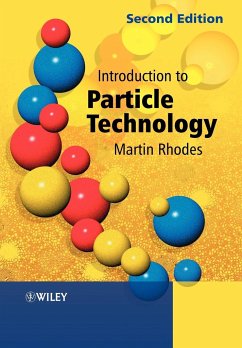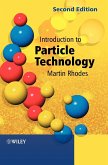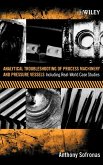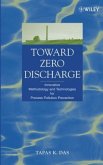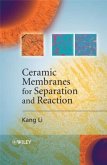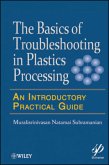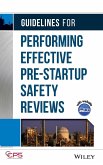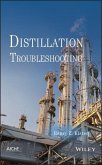- Gebundenes Buch
- Merkliste
- Auf die Merkliste
- Bewerten Bewerten
- Teilen
- Produkt teilen
- Produkterinnerung
- Produkterinnerung
This textbook is a comprehensive introduction to the many concepts of this broad subject. Case studies are provided alongside real life industrial applications illustrating the techniques and theory. This book will be essential reading for students of chemical engineering on particle technology courses.
Die Partikeltechnologie gewinnt in verschiedenen Industriezweigen zunehmend an Bedeutung, insbesondere in den Bereichen Lebensmittel, Pharmazeutik, Chemie, Mineralien und Metall. In diesen Industrien haben Unternehmen mit internen Kenntnissen der Partikeltechnologie einen entscheidenden…mehr
Andere Kunden interessierten sich auch für
![Introduction to Particle Technology 2e Introduction to Particle Technology 2e]() Introduction to Particle Technology 2e246,99 €
Introduction to Particle Technology 2e246,99 €![Analytical Troubleshooting of Process Machinery and Pressure Vessels Analytical Troubleshooting of Process Machinery and Pressure Vessels]() Anthony SofronasAnalytical Troubleshooting of Process Machinery and Pressure Vessels159,99 €
Anthony SofronasAnalytical Troubleshooting of Process Machinery and Pressure Vessels159,99 €![Toward Zero Discharge Toward Zero Discharge]() Toward Zero Discharge234,99 €
Toward Zero Discharge234,99 €![Ceramic Membranes for Separation and Reaction Ceramic Membranes for Separation and Reaction]() Kang LiCeramic Membranes for Separation and Reaction236,99 €
Kang LiCeramic Membranes for Separation and Reaction236,99 €![Basics of Troubleshooting in Plastics Processing Basics of Troubleshooting in Plastics Processing]() Muralisrinivasan Natamai SubramanianBasics of Troubleshooting in Plastics Processing167,99 €
Muralisrinivasan Natamai SubramanianBasics of Troubleshooting in Plastics Processing167,99 €![Guidelines for Performing Effective Pre-Startup Safety Reviews Guidelines for Performing Effective Pre-Startup Safety Reviews]() Center for Chemical Process Safety (CCPS)Guidelines for Performing Effective Pre-Startup Safety Reviews178,99 €
Center for Chemical Process Safety (CCPS)Guidelines for Performing Effective Pre-Startup Safety Reviews178,99 €![Distillation Troubleshooting Distillation Troubleshooting]() Henry Z. KisterDistillation Troubleshooting174,99 €
Henry Z. KisterDistillation Troubleshooting174,99 €-
-
-
This textbook is a comprehensive introduction to the many concepts of this broad subject. Case studies are provided alongside real life industrial applications illustrating the techniques and theory. This book will be essential reading for students of chemical engineering on particle technology courses.
Die Partikeltechnologie gewinnt in verschiedenen Industriezweigen zunehmend an Bedeutung, insbesondere in den Bereichen Lebensmittel, Pharmazeutik, Chemie, Mineralien und Metall. In diesen Industrien haben Unternehmen mit internen Kenntnissen der Partikeltechnologie einen entscheidenden Wettbewerbsvorteil bei der Produktentwicklung, Qualitätskontrolle und Abfallminimierung. Dieses Buch bietet eine umfassende Einführung in die zahlreichen Konzepte dieses Themenkomplexes. Zu den Schlüsselthemen gehören u.a. Charakterisierung, Verarbeitung, Partikelbildung, Sicherheit und Transport. Jedes Kapitel enthält Arbeitsbeispiele mit Berechnungen und Fragen (inklusive Antwortkatalog) sowie echte Industrieanwendungen, die Techniken und Theorie verdeutlichen.
Hinweis: Dieser Artikel kann nur an eine deutsche Lieferadresse ausgeliefert werden.
Die Partikeltechnologie gewinnt in verschiedenen Industriezweigen zunehmend an Bedeutung, insbesondere in den Bereichen Lebensmittel, Pharmazeutik, Chemie, Mineralien und Metall. In diesen Industrien haben Unternehmen mit internen Kenntnissen der Partikeltechnologie einen entscheidenden Wettbewerbsvorteil bei der Produktentwicklung, Qualitätskontrolle und Abfallminimierung. Dieses Buch bietet eine umfassende Einführung in die zahlreichen Konzepte dieses Themenkomplexes. Zu den Schlüsselthemen gehören u.a. Charakterisierung, Verarbeitung, Partikelbildung, Sicherheit und Transport. Jedes Kapitel enthält Arbeitsbeispiele mit Berechnungen und Fragen (inklusive Antwortkatalog) sowie echte Industrieanwendungen, die Techniken und Theorie verdeutlichen.
Hinweis: Dieser Artikel kann nur an eine deutsche Lieferadresse ausgeliefert werden.
Produktdetails
- Produktdetails
- Verlag: Wiley & Sons
- 2. Aufl.
- Seitenzahl: 480
- Erscheinungstermin: 11. März 2008
- Englisch
- Abmessung: 244mm x 170mm x 26mm
- Gewicht: 795g
- ISBN-13: 9780470014288
- ISBN-10: 0470014288
- Artikelnr.: 23333474
- Herstellerkennzeichnung
- Libri GmbH
- Europaallee 1
- 36244 Bad Hersfeld
- 06621 890
- Verlag: Wiley & Sons
- 2. Aufl.
- Seitenzahl: 480
- Erscheinungstermin: 11. März 2008
- Englisch
- Abmessung: 244mm x 170mm x 26mm
- Gewicht: 795g
- ISBN-13: 9780470014288
- ISBN-10: 0470014288
- Artikelnr.: 23333474
- Herstellerkennzeichnung
- Libri GmbH
- Europaallee 1
- 36244 Bad Hersfeld
- 06621 890
Martin Rhodes holds a Bachelor's degree in chemical engineering and a PhD in particle technology from Bradford University in the UK, industrial experience in chemical and combustion engineering and many years experience as an academic at Bradford and Monash Universities. He has research interests in various aspects of gas fluidization and particle technology, areas in which he has many refereed publications in journals and international conference proceedings. Martin is on the editorial boards of Powder Technology and KONA and on the advisory board of Advanced Powder technology. Martin has a keen interests in particle technology education and has published books and CDROM on Laboratory Demonstrations and directed continuing education courses for industry in the UK and Australia. He was co-founder of the Australasian Particle Technology Society. Martin has a Personal Chair in the Department of Chemical Engineering at Monash University, Australia, where he is presently Head of Department.
About the Contributors.
Preface to the Second Edition.
Preface to the First Edition.
Introduction..
1. Particle Size Analysis.
1.1 Introduction.
1.2 Describing The Size Of A Single Particle.
1.3 Description Of Populations Of Particles.
1.4 Conversion Between Distributions.
1.5 Describing The Population By A Single Number.
1.6 Equivalence Of Means.
1.7 Common Methods Of Displaying Size Distributions.
1.8 Methods Of Particle Size Measurement.
1.9 Sampling.
1.10 Worked Examples.
Test Yourself.
Exercises.
2. Single Particles in a Fluid.
2.1 Motion Of Solid Particles In A Fluid.
2.2 Particles Falling Under Gravity Through A Fluid.
2.3 Non-Spherical Particles.
2.4 Effect Of Boundaries On Terminal Velocity.
2.5 Further Reading.
2.6 Worked Examples.
Test Yourself.
Exercises.
3. Multiple Particle Systems.
3.1 Settling Of A Suspension Of Particles.
3.2 Batch Settling.
3.3 Continuous Settling.
3.4 Worked Examples.
Test Yourself.
Exercises.
4. Slurry Transport.
4.1 Introduction.
4.2 Flow Condition.
4.3 Rheological Models For Homogeneous Slurries.
4.4 Heterogeneous Slurries.
4.5 Components Of A Slurry Flow System.
4.6 Further Reading.
4.7 Worked Examples.
Exercises.
Test Yourself.
5. Colloids and Fine Particles.
5.1 Introduction.
5.2 Brownian Motion.
5.3 Surface Forces.
5.4 Result of Surface Forces on Behaviour in Air and Water.
5.5 Influences of Particle Size and Surface Forces on Solid/Liquid
Separation by Sedimentation.
5.6 Suspension Rheology.
5.7 Influence of Surface Forces on Suspension Flow.
5.8 Nanoparticles.
5.9 Worked Examples.
Test Yourself.
Exercises.
6. Fluid Flow Through a Packed Bed of Particles.
6.1 Pressure Drop-Flow Relationship.
6.2 Filtration.
6.3 Further Reading.
6.4 Worked Examples.
Test Yourself.
Exercises.
7. Fluidization.
7.1 Fundamentals.
7.2 Relevant Powder And Particle Properties.
7.3 Bubbling And Non-Bubbling Fluidization.
7.4 Classification Of Powders.
7.5 Expansion Of A Fluidized Bed.
7.6 Entrainment.
7.7 Heat Transfer In Fluidized Beds.
7.8 Applications Of Fluidized Beds.
7.9 A Simple Model For The Bubbling Fluidized Bed Reactor.
7.10 Some Practical Considerations.
7.11 Worked Examples.
Test Yourself.
Exercises.
8. Pneumatic Transport and Standpipes.
8.1 Pneumatic Transport.
8.2 Standpipes.
8.3 Further Reading.
8.4 Worked Examples.
Test Yourself.
Exercises.
9. Separation of Particles From a Gas: Gas Cyclones.
9.1 Gas Cyclones - Description.
9.2 Flow Characteristics.
9.3 Efficiency Of Separation.
9.4 Scale-Up Of Cyclones.
9.5 Range Of Operation.
9.6 Some Practical Design And Operation Details.
9.7 Worked Examples.
Test Yourself.
Exercises.
10. Storage and Flow of Powders - Hopper Design.
10.1 Introduction.
10.2 Mass Flow And Core Flow.
10.3 The Design Philosophy.
10.4 Shear Cell Test.
10.5 Analysis Of Shear Cell Test Results.
10.6 Summary Of Design Procedure.
10.7 Discharge Aids.
10.8 Pressure On The Base Of A Tall Cylindrical Bin.
10.9 Mass Flow Rates.
10.10 Conclusions.
10.11 Worked Examples.
Test Yourself.
Exercises.
11. Mixing and Segregation.
11.1 Introduction.
11.2 Types Of Mixture.
11.3 Segregation.
11.4 Reduction Of Segregation.
11.5 Equipment For Particulate Mixing.
11.6 Assessing The Mixture.
11.7 Worked Examples.
Exercises.
12. Particle Size Reduction.
12.1 Introduction.
12.2 Particle Fracture Mechanisms.
12.3 Model Predicting Energy Requirement And Product Size Distribution.
12.4 Types Of Comminution Equipment.
12.5 Worked Examples.
Test Yourself.
Exercises.
13. Size Enlargement.
13.1 Introduction.
13.2 Interparticle Forces.
13.3 Granulation.
13.4 Worked Examples.
Exercises.
14. Health Effects of Fine Powders.
14.1 Introduction.
14.2 The Human Respiratory System.
14.3 Interaction of Fine Powders with the Respiratory System.
14.4 Pulmonary Delivery of Drugs.
14.5 Harmful Effects of Fine Powders.
Test Yourself.
Exercises.
15. Fire and Explosion Hazards of Fine Powders.
15.1 Introduction.
15.2 Combustion Fundamentals.
15.3 Combustion In Dust Clouds.
15.4 Control Of The Hazard.
15.5 Worked Examples.
Test Yourself.
Exercises.
16. Case Studies.
16.1 Case Study 1.
16.2 Case Study 2.
16.3 Case Study 3.
16.4 Case Study 4.
16.5 Case Study 5.
16.6 Case Study 6.
16.7 Case Study 7.
16.8 Case Study 8.
Notation.
References.
Index.
Preface to the Second Edition.
Preface to the First Edition.
Introduction..
1. Particle Size Analysis.
1.1 Introduction.
1.2 Describing The Size Of A Single Particle.
1.3 Description Of Populations Of Particles.
1.4 Conversion Between Distributions.
1.5 Describing The Population By A Single Number.
1.6 Equivalence Of Means.
1.7 Common Methods Of Displaying Size Distributions.
1.8 Methods Of Particle Size Measurement.
1.9 Sampling.
1.10 Worked Examples.
Test Yourself.
Exercises.
2. Single Particles in a Fluid.
2.1 Motion Of Solid Particles In A Fluid.
2.2 Particles Falling Under Gravity Through A Fluid.
2.3 Non-Spherical Particles.
2.4 Effect Of Boundaries On Terminal Velocity.
2.5 Further Reading.
2.6 Worked Examples.
Test Yourself.
Exercises.
3. Multiple Particle Systems.
3.1 Settling Of A Suspension Of Particles.
3.2 Batch Settling.
3.3 Continuous Settling.
3.4 Worked Examples.
Test Yourself.
Exercises.
4. Slurry Transport.
4.1 Introduction.
4.2 Flow Condition.
4.3 Rheological Models For Homogeneous Slurries.
4.4 Heterogeneous Slurries.
4.5 Components Of A Slurry Flow System.
4.6 Further Reading.
4.7 Worked Examples.
Exercises.
Test Yourself.
5. Colloids and Fine Particles.
5.1 Introduction.
5.2 Brownian Motion.
5.3 Surface Forces.
5.4 Result of Surface Forces on Behaviour in Air and Water.
5.5 Influences of Particle Size and Surface Forces on Solid/Liquid
Separation by Sedimentation.
5.6 Suspension Rheology.
5.7 Influence of Surface Forces on Suspension Flow.
5.8 Nanoparticles.
5.9 Worked Examples.
Test Yourself.
Exercises.
6. Fluid Flow Through a Packed Bed of Particles.
6.1 Pressure Drop-Flow Relationship.
6.2 Filtration.
6.3 Further Reading.
6.4 Worked Examples.
Test Yourself.
Exercises.
7. Fluidization.
7.1 Fundamentals.
7.2 Relevant Powder And Particle Properties.
7.3 Bubbling And Non-Bubbling Fluidization.
7.4 Classification Of Powders.
7.5 Expansion Of A Fluidized Bed.
7.6 Entrainment.
7.7 Heat Transfer In Fluidized Beds.
7.8 Applications Of Fluidized Beds.
7.9 A Simple Model For The Bubbling Fluidized Bed Reactor.
7.10 Some Practical Considerations.
7.11 Worked Examples.
Test Yourself.
Exercises.
8. Pneumatic Transport and Standpipes.
8.1 Pneumatic Transport.
8.2 Standpipes.
8.3 Further Reading.
8.4 Worked Examples.
Test Yourself.
Exercises.
9. Separation of Particles From a Gas: Gas Cyclones.
9.1 Gas Cyclones - Description.
9.2 Flow Characteristics.
9.3 Efficiency Of Separation.
9.4 Scale-Up Of Cyclones.
9.5 Range Of Operation.
9.6 Some Practical Design And Operation Details.
9.7 Worked Examples.
Test Yourself.
Exercises.
10. Storage and Flow of Powders - Hopper Design.
10.1 Introduction.
10.2 Mass Flow And Core Flow.
10.3 The Design Philosophy.
10.4 Shear Cell Test.
10.5 Analysis Of Shear Cell Test Results.
10.6 Summary Of Design Procedure.
10.7 Discharge Aids.
10.8 Pressure On The Base Of A Tall Cylindrical Bin.
10.9 Mass Flow Rates.
10.10 Conclusions.
10.11 Worked Examples.
Test Yourself.
Exercises.
11. Mixing and Segregation.
11.1 Introduction.
11.2 Types Of Mixture.
11.3 Segregation.
11.4 Reduction Of Segregation.
11.5 Equipment For Particulate Mixing.
11.6 Assessing The Mixture.
11.7 Worked Examples.
Exercises.
12. Particle Size Reduction.
12.1 Introduction.
12.2 Particle Fracture Mechanisms.
12.3 Model Predicting Energy Requirement And Product Size Distribution.
12.4 Types Of Comminution Equipment.
12.5 Worked Examples.
Test Yourself.
Exercises.
13. Size Enlargement.
13.1 Introduction.
13.2 Interparticle Forces.
13.3 Granulation.
13.4 Worked Examples.
Exercises.
14. Health Effects of Fine Powders.
14.1 Introduction.
14.2 The Human Respiratory System.
14.3 Interaction of Fine Powders with the Respiratory System.
14.4 Pulmonary Delivery of Drugs.
14.5 Harmful Effects of Fine Powders.
Test Yourself.
Exercises.
15. Fire and Explosion Hazards of Fine Powders.
15.1 Introduction.
15.2 Combustion Fundamentals.
15.3 Combustion In Dust Clouds.
15.4 Control Of The Hazard.
15.5 Worked Examples.
Test Yourself.
Exercises.
16. Case Studies.
16.1 Case Study 1.
16.2 Case Study 2.
16.3 Case Study 3.
16.4 Case Study 4.
16.5 Case Study 5.
16.6 Case Study 6.
16.7 Case Study 7.
16.8 Case Study 8.
Notation.
References.
Index.
About the Contributors.
Preface to the Second Edition.
Preface to the First Edition.
Introduction..
1. Particle Size Analysis.
1.1 Introduction.
1.2 Describing The Size Of A Single Particle.
1.3 Description Of Populations Of Particles.
1.4 Conversion Between Distributions.
1.5 Describing The Population By A Single Number.
1.6 Equivalence Of Means.
1.7 Common Methods Of Displaying Size Distributions.
1.8 Methods Of Particle Size Measurement.
1.9 Sampling.
1.10 Worked Examples.
Test Yourself.
Exercises.
2. Single Particles in a Fluid.
2.1 Motion Of Solid Particles In A Fluid.
2.2 Particles Falling Under Gravity Through A Fluid.
2.3 Non-Spherical Particles.
2.4 Effect Of Boundaries On Terminal Velocity.
2.5 Further Reading.
2.6 Worked Examples.
Test Yourself.
Exercises.
3. Multiple Particle Systems.
3.1 Settling Of A Suspension Of Particles.
3.2 Batch Settling.
3.3 Continuous Settling.
3.4 Worked Examples.
Test Yourself.
Exercises.
4. Slurry Transport.
4.1 Introduction.
4.2 Flow Condition.
4.3 Rheological Models For Homogeneous Slurries.
4.4 Heterogeneous Slurries.
4.5 Components Of A Slurry Flow System.
4.6 Further Reading.
4.7 Worked Examples.
Exercises.
Test Yourself.
5. Colloids and Fine Particles.
5.1 Introduction.
5.2 Brownian Motion.
5.3 Surface Forces.
5.4 Result of Surface Forces on Behaviour in Air and Water.
5.5 Influences of Particle Size and Surface Forces on Solid/Liquid
Separation by Sedimentation.
5.6 Suspension Rheology.
5.7 Influence of Surface Forces on Suspension Flow.
5.8 Nanoparticles.
5.9 Worked Examples.
Test Yourself.
Exercises.
6. Fluid Flow Through a Packed Bed of Particles.
6.1 Pressure Drop-Flow Relationship.
6.2 Filtration.
6.3 Further Reading.
6.4 Worked Examples.
Test Yourself.
Exercises.
7. Fluidization.
7.1 Fundamentals.
7.2 Relevant Powder And Particle Properties.
7.3 Bubbling And Non-Bubbling Fluidization.
7.4 Classification Of Powders.
7.5 Expansion Of A Fluidized Bed.
7.6 Entrainment.
7.7 Heat Transfer In Fluidized Beds.
7.8 Applications Of Fluidized Beds.
7.9 A Simple Model For The Bubbling Fluidized Bed Reactor.
7.10 Some Practical Considerations.
7.11 Worked Examples.
Test Yourself.
Exercises.
8. Pneumatic Transport and Standpipes.
8.1 Pneumatic Transport.
8.2 Standpipes.
8.3 Further Reading.
8.4 Worked Examples.
Test Yourself.
Exercises.
9. Separation of Particles From a Gas: Gas Cyclones.
9.1 Gas Cyclones - Description.
9.2 Flow Characteristics.
9.3 Efficiency Of Separation.
9.4 Scale-Up Of Cyclones.
9.5 Range Of Operation.
9.6 Some Practical Design And Operation Details.
9.7 Worked Examples.
Test Yourself.
Exercises.
10. Storage and Flow of Powders - Hopper Design.
10.1 Introduction.
10.2 Mass Flow And Core Flow.
10.3 The Design Philosophy.
10.4 Shear Cell Test.
10.5 Analysis Of Shear Cell Test Results.
10.6 Summary Of Design Procedure.
10.7 Discharge Aids.
10.8 Pressure On The Base Of A Tall Cylindrical Bin.
10.9 Mass Flow Rates.
10.10 Conclusions.
10.11 Worked Examples.
Test Yourself.
Exercises.
11. Mixing and Segregation.
11.1 Introduction.
11.2 Types Of Mixture.
11.3 Segregation.
11.4 Reduction Of Segregation.
11.5 Equipment For Particulate Mixing.
11.6 Assessing The Mixture.
11.7 Worked Examples.
Exercises.
12. Particle Size Reduction.
12.1 Introduction.
12.2 Particle Fracture Mechanisms.
12.3 Model Predicting Energy Requirement And Product Size Distribution.
12.4 Types Of Comminution Equipment.
12.5 Worked Examples.
Test Yourself.
Exercises.
13. Size Enlargement.
13.1 Introduction.
13.2 Interparticle Forces.
13.3 Granulation.
13.4 Worked Examples.
Exercises.
14. Health Effects of Fine Powders.
14.1 Introduction.
14.2 The Human Respiratory System.
14.3 Interaction of Fine Powders with the Respiratory System.
14.4 Pulmonary Delivery of Drugs.
14.5 Harmful Effects of Fine Powders.
Test Yourself.
Exercises.
15. Fire and Explosion Hazards of Fine Powders.
15.1 Introduction.
15.2 Combustion Fundamentals.
15.3 Combustion In Dust Clouds.
15.4 Control Of The Hazard.
15.5 Worked Examples.
Test Yourself.
Exercises.
16. Case Studies.
16.1 Case Study 1.
16.2 Case Study 2.
16.3 Case Study 3.
16.4 Case Study 4.
16.5 Case Study 5.
16.6 Case Study 6.
16.7 Case Study 7.
16.8 Case Study 8.
Notation.
References.
Index.
Preface to the Second Edition.
Preface to the First Edition.
Introduction..
1. Particle Size Analysis.
1.1 Introduction.
1.2 Describing The Size Of A Single Particle.
1.3 Description Of Populations Of Particles.
1.4 Conversion Between Distributions.
1.5 Describing The Population By A Single Number.
1.6 Equivalence Of Means.
1.7 Common Methods Of Displaying Size Distributions.
1.8 Methods Of Particle Size Measurement.
1.9 Sampling.
1.10 Worked Examples.
Test Yourself.
Exercises.
2. Single Particles in a Fluid.
2.1 Motion Of Solid Particles In A Fluid.
2.2 Particles Falling Under Gravity Through A Fluid.
2.3 Non-Spherical Particles.
2.4 Effect Of Boundaries On Terminal Velocity.
2.5 Further Reading.
2.6 Worked Examples.
Test Yourself.
Exercises.
3. Multiple Particle Systems.
3.1 Settling Of A Suspension Of Particles.
3.2 Batch Settling.
3.3 Continuous Settling.
3.4 Worked Examples.
Test Yourself.
Exercises.
4. Slurry Transport.
4.1 Introduction.
4.2 Flow Condition.
4.3 Rheological Models For Homogeneous Slurries.
4.4 Heterogeneous Slurries.
4.5 Components Of A Slurry Flow System.
4.6 Further Reading.
4.7 Worked Examples.
Exercises.
Test Yourself.
5. Colloids and Fine Particles.
5.1 Introduction.
5.2 Brownian Motion.
5.3 Surface Forces.
5.4 Result of Surface Forces on Behaviour in Air and Water.
5.5 Influences of Particle Size and Surface Forces on Solid/Liquid
Separation by Sedimentation.
5.6 Suspension Rheology.
5.7 Influence of Surface Forces on Suspension Flow.
5.8 Nanoparticles.
5.9 Worked Examples.
Test Yourself.
Exercises.
6. Fluid Flow Through a Packed Bed of Particles.
6.1 Pressure Drop-Flow Relationship.
6.2 Filtration.
6.3 Further Reading.
6.4 Worked Examples.
Test Yourself.
Exercises.
7. Fluidization.
7.1 Fundamentals.
7.2 Relevant Powder And Particle Properties.
7.3 Bubbling And Non-Bubbling Fluidization.
7.4 Classification Of Powders.
7.5 Expansion Of A Fluidized Bed.
7.6 Entrainment.
7.7 Heat Transfer In Fluidized Beds.
7.8 Applications Of Fluidized Beds.
7.9 A Simple Model For The Bubbling Fluidized Bed Reactor.
7.10 Some Practical Considerations.
7.11 Worked Examples.
Test Yourself.
Exercises.
8. Pneumatic Transport and Standpipes.
8.1 Pneumatic Transport.
8.2 Standpipes.
8.3 Further Reading.
8.4 Worked Examples.
Test Yourself.
Exercises.
9. Separation of Particles From a Gas: Gas Cyclones.
9.1 Gas Cyclones - Description.
9.2 Flow Characteristics.
9.3 Efficiency Of Separation.
9.4 Scale-Up Of Cyclones.
9.5 Range Of Operation.
9.6 Some Practical Design And Operation Details.
9.7 Worked Examples.
Test Yourself.
Exercises.
10. Storage and Flow of Powders - Hopper Design.
10.1 Introduction.
10.2 Mass Flow And Core Flow.
10.3 The Design Philosophy.
10.4 Shear Cell Test.
10.5 Analysis Of Shear Cell Test Results.
10.6 Summary Of Design Procedure.
10.7 Discharge Aids.
10.8 Pressure On The Base Of A Tall Cylindrical Bin.
10.9 Mass Flow Rates.
10.10 Conclusions.
10.11 Worked Examples.
Test Yourself.
Exercises.
11. Mixing and Segregation.
11.1 Introduction.
11.2 Types Of Mixture.
11.3 Segregation.
11.4 Reduction Of Segregation.
11.5 Equipment For Particulate Mixing.
11.6 Assessing The Mixture.
11.7 Worked Examples.
Exercises.
12. Particle Size Reduction.
12.1 Introduction.
12.2 Particle Fracture Mechanisms.
12.3 Model Predicting Energy Requirement And Product Size Distribution.
12.4 Types Of Comminution Equipment.
12.5 Worked Examples.
Test Yourself.
Exercises.
13. Size Enlargement.
13.1 Introduction.
13.2 Interparticle Forces.
13.3 Granulation.
13.4 Worked Examples.
Exercises.
14. Health Effects of Fine Powders.
14.1 Introduction.
14.2 The Human Respiratory System.
14.3 Interaction of Fine Powders with the Respiratory System.
14.4 Pulmonary Delivery of Drugs.
14.5 Harmful Effects of Fine Powders.
Test Yourself.
Exercises.
15. Fire and Explosion Hazards of Fine Powders.
15.1 Introduction.
15.2 Combustion Fundamentals.
15.3 Combustion In Dust Clouds.
15.4 Control Of The Hazard.
15.5 Worked Examples.
Test Yourself.
Exercises.
16. Case Studies.
16.1 Case Study 1.
16.2 Case Study 2.
16.3 Case Study 3.
16.4 Case Study 4.
16.5 Case Study 5.
16.6 Case Study 6.
16.7 Case Study 7.
16.8 Case Study 8.
Notation.
References.
Index.

